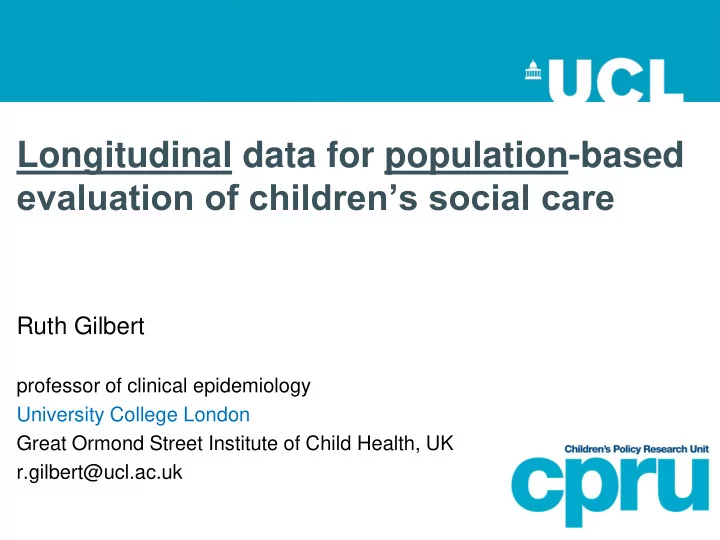

Longitudinal data for population-based evaluation of children’s social care Ruth Gilbert professor of clinical epidemiology University College London Great Ormond Street Institute of Child Health, UK r.gilbert@ucl.ac.uk
Longitudinal = linked events over time Longitudinal data for …. …case management of …managing services, developing policy for individuals populations • • De-identified/ anonymised Individuals identifiable • • Data limited to those Includes people not receiving services receiving DIRECT care • Define groups for targeted services 2
What does population-based, longitudinal data tell us about services? A child life course perspective 3
CiN is a common childhood experience Yearly prevalence 2.7% of children <5y Longitudinal data – EVER CiN By 18 years children EVER CiN likely to exceed 30% 4
What is driving rise in out of home care? Driven by: • Duration of stay • Number ever entering • Repeat entries 5
Longitudinal data – number EVER in care increasing 3.3% Cross-sectional prevalence of 0.6% 2.0% 2.0% 1.6% 0.9% 0.9% 0.5%
Ever in care very high for Black and Mixed ethnic groups – but rise driven by white ethnic group Percentage of children born 1992-94 placed in care, by ethnic group 9.5% 6.7% 3.4% 2.7%
Proportion of children ever in care varies between local authorities 7% <1%
Re-entry to care within 5 years decreasing Re-entries • Decreasing over time Increased for: • Adolescents • Voluntary placement • Short placement • Repeated placements 9
Children in care have very high levels of SEND n= 544,879 children Birth 2011 School entry Year 11 Year 6 Reception year Age 16y Age 11y Age 4-5y Special education needs No social care Any CiN Any period looked after Results not shown as work in progress Contact Matthew Jay with any queries matthew.jay.15@ucl.ac.uk 10 Jay, 2018, unpublished
Linking longitudinal datasets 11
Longitudinal datasets from related services Pregnancy Pregnancy Birth Hospital admissions Self harm HEALTH SERVICE Admissions Adolescence Young adulthood Childhood Birth SCHOOLS Special School Educational exclusion needs Birth Placed in care SOCIAL Care proceedings CiN (family courts) SERVICES CiN referral 12
Linking longitudinal events Pregnancy Pregnancy Birth Hospital admissions Self harm HEALTH SERVICE Admissions Adolescence Young adulthood Childhood Birth SCHOOLS Special School Educational exclusion needs Birth Placed in care SOCIAL Care proceedings CiN (family courts) SERVICES CiN CiN referral referral 13
Linking longitudinal datasets Pregnancy Pregnancy Birth Hospital admissions Self harm HEALTH SERVICE Admissions Adolescence Young adulthood Childhood Birth SCHOOLS Special School Educational exclusion needs Birth Placed in care SOCIAL Care proceedings CiN (family courts) SERVICES CiN referral 14
Linked longitudinal data HEALTH Referred to Placed in care SERVICE Pregnancy children’s Birth Pregnancy social care Hospital SCHOOLS Special Self harm School Care proceedings Educational exclusion CiN (family courts) SOCIAL needs referral SERVICES Admissions Adolescence Young adulthood Childhood 15
Use ANONYMISED linked longitudinal data… …and maintain confidentiality and trust ‘ Identifiability spectrum ’ by Understanding Patient Data is licensed under CC BY. 16
Linkage error matters Match status Pair from same subject Pair from different subjects (matches) (non-matches) False match Identified match Links Linkage Non- status Missed match Identified non-match links Underestimate Weaken associations events in groups with poor quality data
Linkage error: Linkage error: • • is not random is not random • • depends on data quality depends on data quality • • is worse for certain groups eg: is worse for certain groups eg: • Marginalised (homeless, insecure accommodation) • Uncertain dates of birth (runaways, asylum seekers) • Unconventional surnames • Misleading / missing information (drug user, parent withholding details, foster and adoptive parents) • Address issues - communal establishments, traveller, changing care placements • Multiple births and siblings
Linkage error can be reduced or taken into account by: • Using probabilistic linkage (account for uncertain linkages) • Avoiding encrypted linkages – increases error, obscures causes • Validating methods against a gold standard (if possible) • Conducting sensitivity analyses • Comparing linked and unlinked and take disparities into account • Comparing against expected results from external evidence • Transparent reporting of linkage methods
Summary Linked longitudinal, population-based data provides evidence for policy and service decisions at local and national level. Anonymity and confidentiality is critical for public support for unconsented use of population data. Linkage error addressed through methods and transparency.
References: • Mc Grath-Lone, L. Using longitudinal administrative data to characterise the use of out- of-home care among children in England. UCL PhD thesis http://discovery.ucl.ac.uk/10038396/ • Mc Grath-Lone, L, et al. Factors associate with re-entry to out-of-home care among children in England. Child Abuse and Neglect 2017;63:73-83. • Mc Grath-Lone, L, et al. Changes in first entry to out-of-home care from 1992 to 2012 among children in England. Child Abuse and Neglect 2016;51:163-171. • Matthew A Jay, et al. Who cares for children? Population data for family justice research. http://wp.lancs.ac.uk/observatory-scoping-study/files/2017/10/FJO-NATIONAL-DATA- SCOPING-FINAL.pdf • Bohensky et al 2010. Data Linkage: A powerful research tool with potential problems. BMC Health Services Research • Harron KL, et al. A guide to evaluating linkage quality for the analysis of linked data. Int J Epidemiol. 2017 Oct 1;46(5):1699-1710. • Gilbert R, et al. GUILD: GUidance for Information about Linking Data sets. J Public Health (Oxf). 2018 Mar 1;40(1):191-198.
Socio-legal epidemiology group, UCL Jay, Wijlaars, Pearson, Woodman, Gilbert Record linkage methodology group, UCL Harron, Goldstein, Doidge, Blackburn, Gilbert 22
Recommend
More recommend